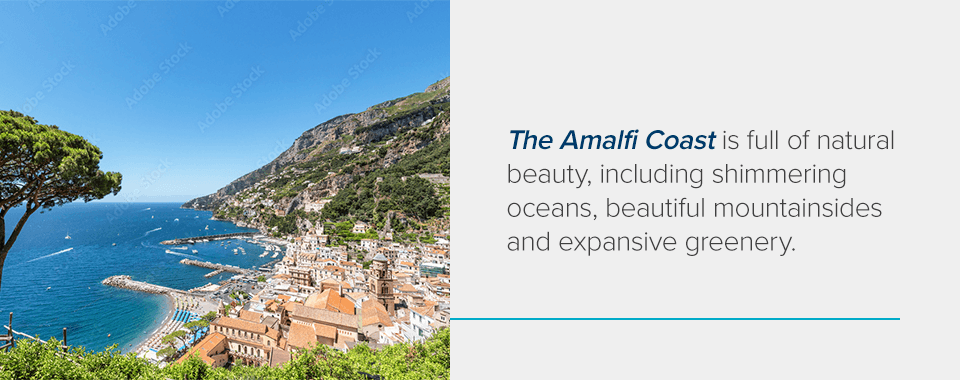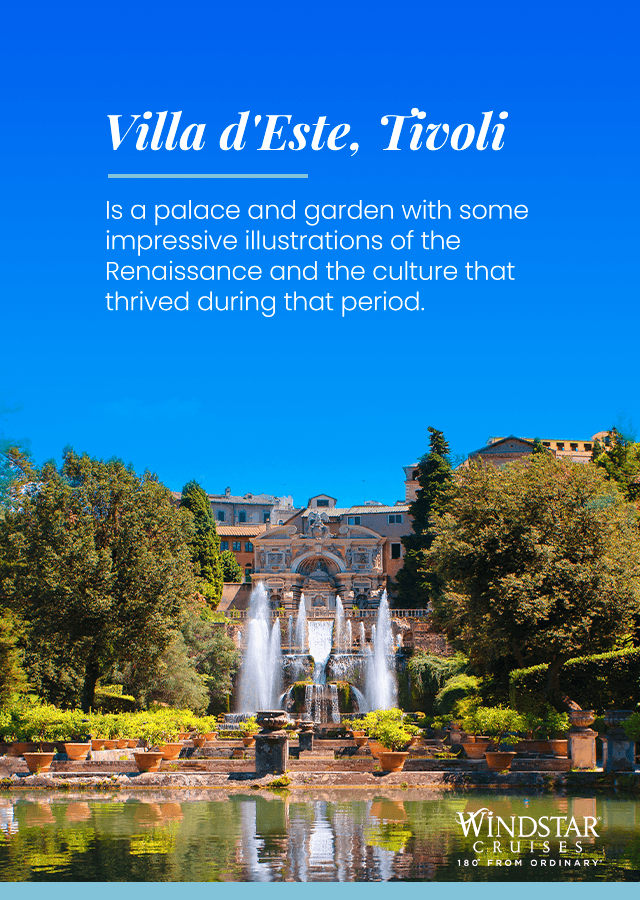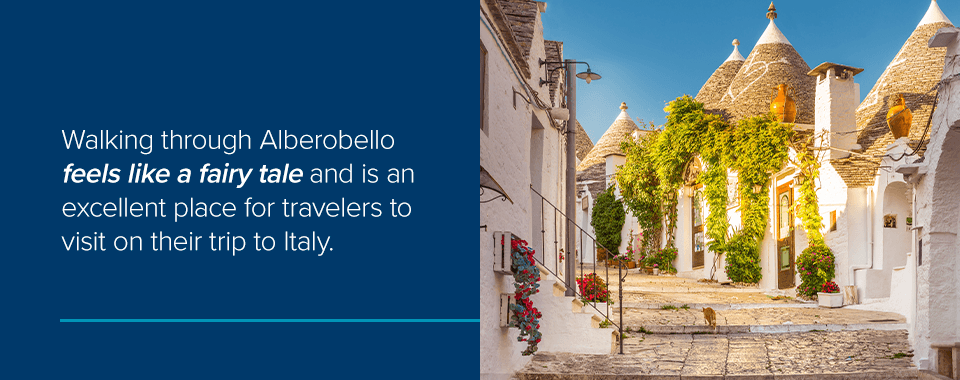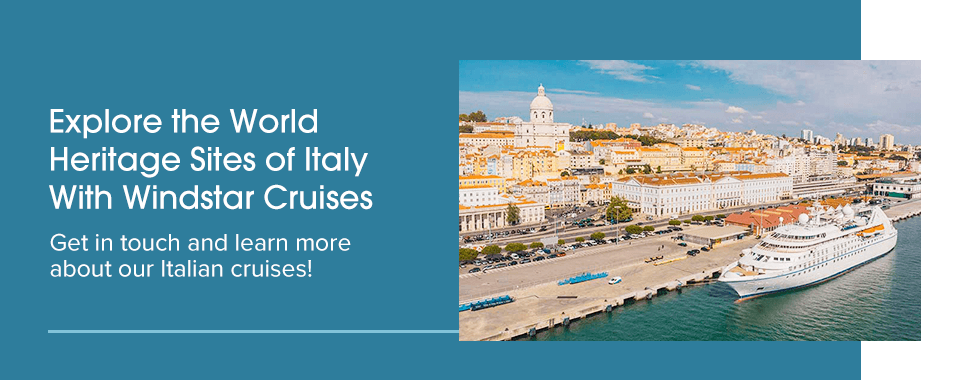
Italy has more World Heritage sites than anywhere in the world, with over 50 officially designated sites and many tentative spots up for consideration. Italy has a significant cultural and artistic influence on the Western world and is one of the best places for travelers to visit when exploring the vast culture of Europe.
With so many sites to see, there are bound to be a few that strike your interest. Below, we’ve compiled a list of some of the best World Heritage sites to see on your next visit to Italy.
In This Article
- 20 Best UNESCO World Heritage Sites to Visit In Italy
- Orto Botanico, Padua
- Archaeological Areas of Pompeii, Herculaneum and Torre Annunziata
- The Santa Maria delle Grazie Church and Convent
- City of Verona
- Costiera Amalfitana
- Etruscan Necropolises of Cerveteri and Tarquinia
- Historic Center of Florence
- Medici Villas and Gardens in Tuscany
- Historic Center of Rome
- Villa d’Este, Tivoli
- Venice
- The Dolomites
- Prehistoric Pile Dwellings Around the Alps
- The Royal Palace of Caserta
- Crespi d’Adda
- Mount Etna
- Cinque Terre
- Alberobello
- Piazza del Duomo, Pisa
- Sassi di Matera
- Explore the World Heritage Sites of Italy With Windstar Cruises
20 Best UNESCO World Heritage Sites to Visit In Italy
Italy has a lot to offer for travelers, including botanical gardens, archaeological sites showcasing the history of ancient cultural organizations and places of religious worship. Many of these sites have been designated as UNESCO World Heritage sites in Italy, showcasing their historical and cultural influence. Travelers can visit these sites to get a glimpse into history, whether it’s to see what it was like to live during Roman times or how religion and cultural changes altered the country over time.
Below, you’ll learn about some of the most popular places on the UNESCO World Heritage list for Italy, helping you create your own list of places to visit when touring the great country.

1. Orto Botanico, Padua
The first botanical garden originated in 1545 in Padua and has inspired the creation of other botanical gardens worldwide. The Orto Botanico still has its original layout, comprised of a circular plot in the center, meant to represent the world. The central plot is surrounded by water, and other elements were added over time, such as ornamental entrances and greenhouses. The Orto Botanico continues to operate as a center for scientific research.
The Botanical Garden of Padua is excellent for those who enjoy rare plants and historical manuscripts from centuries ago. You can walk around the flowers and various plants and catch a glimpse of the garden as it existed in the 16th century.
2. Archaeological Areas of Pompeii, Herculaneum and Torre Annunziata
Mount Vesuvius erupted in A.D. 79 and engulfed Pompeii, Herculaneum and surrounding areas. These cities were excavated and opened to the public in the middle of the 18th century. Herculaneum is the remains of a well-preserved holiday resort, and Pompeii is a vast commercial town with a rich history. You can still see the wall paintings featured in the Villa Oplontis, which helps give travelers a glimpse into the wealthier lifestyles of early Roman times.
These Italian sites are excellent places for those interested in the rich history of Italian culture and lifestyles. Due to the exceptional state of these archaeological sites, there are no other parallels in the world.
3. The Santa Maria delle Grazie Church and Convent
The Santa Maria delle Grazie comprises three cloisters, a basilica, a library and a refectory. The famous painting “The Last Supper” is located on the north wall of the refectory, which was painted by the famous artist Leonardo da Vinci and has influenced art and religion for centuries.
The painting portrayed the Apostle’s reaction when Jesus told them that one of them would betray them. The painting has been thoroughly maintained and restored throughout the centuries and is an excellent reason to visit the church and Dominican Convent of Santa Maria delle Grazie.
Apart from seeing “The Last Supper,” The architecture of the complex is also an excellent reason to visit the church and convent. You can step into religious and cultural history when visiting Santa Maria delle Grazie.
4. City of Verona
Verona is one of the most well-known cities in Italy, and if you’re familiar with Shakespeare, you may remember Verona as the classic set of “Romeo and Juliet.” Verona was founded in the first century B.C. and flourished starting in the 13th and 14th centuries under the rule of the Scaliger family and between the 15th and 18th centuries as part of the Republic of Venice.
Verona is home to numerous monuments from the Medieval and Renaissance periods and is an excellent example of a military stronghold in Europe’s history. Visiting the city of Verona allows you to learn more about Italy’s history and explore the cultural city’s natural beauty.
5. Costiera Amalfitana
Costiera Amalfitana, also known as the Amalfi Coast, is one of the most stunning Italian sites you can visit on your trip to this European country. The Amalfi Coast is full of natural beauty, including shimmering oceans, beautiful mountainsides and expansive greenery.

The number of small towns in this region showcases impressive architectural and artistic works significant to Italy. You can also find terraced orchards and vineyards, an excellent way to unwind on vacation to Italy. The Amalfi Coat is a popular holiday destination, whether you’re celebrating a summer holiday or visiting in winter.
6. Etruscan Necropolises of Cerveteri and Tarquinia
The Etruscan cemeteries showcase the different rituals and burial practices during the ninth and first centuries B.C. The area is also a testament to the achievements of the Etruscan culture, which helped develop the urban civilizations within the northern Mediterranean. Some of the cemeteries are cut into the ground and topped by burial mounds, many of which feature carvings or wall paintings. The necropolis also features many tombs constructed almost like a city with streets, neighborhoods and small squares.
The cemeteries are some of the only surviving evidence of Etruscan architecture. Visiting the site helps give you an idea of what older civilizations were like and what funeral rites they used to honor their people.
7. Historic Center of Florence
Florence is known as one of the most artistic cities on Italy’s UNESCO World Heritage sites list, as it is one of the symbols of the Renaissance in Italy. Florence rose to cultural and economic superiority between the 15th and 16th centuries and has over 600 years of impressive artistic activity, such as the Cathedral of Santa Maria del Fiore from the 13th century and the Church of Santa Croce. Florence was once home to many great artistic masters, such as Michelangelo, Giotto, Botticelli and Brunelleschi.
Florence is enclosed in old medieval walls and is an excellent place to visit to view the home of artistic influence during the Renaissance. The city’s history, architecture and artistic influence make it an ideal destination for travelers.
8. Medici Villas and Gardens in Tuscany
There are 12 villas and two gardens spread within Tuscany that make up this UNESCO World Heritage site in Italy. The villas and gardens showcase the influence of the Medici family within Europe and how they helped support the arts.
The villas and gardens incorporate a system that creates harmony with nature, knowledge and the arts. This Italian World Heritage site is one of the jewels of the Florentine Renaissance and architecture. The Medici family had an impressive influence on modern European culture, making it what we know today.
9. Historic Center of Rome
According to legend, Rome was founded by Romulus and Remus in 753 B.C. Rome was the first center of the Roman Republic and the Roman Empire and finally became the capital of the Christian world in the fourth century. Rome is also famous for hosting some of the best festivals in Italy and is linked with some of the most important events in history.
Rome is an excellent reflection of the Renaissance and Baroque periods. Rome has many notable monuments and buildings, including the Mausoleums of Augustus and Hadrian, the Forums, the Pantheon and the Column of Marcus Aurelius. Rome still holds much of the influence it had when it became the spiritual capital of Christianity and is an excellent place for travelers to visit.
10. Villa d’Este, Tivoli
The Villa d’Este Palace is a palace and garden with some impressive illustrations of the Renaissance and the culture that thrived during that period. The palace and gardens host innovative designs and architectural components, such as ornamental basins and fountains. The palace gardens quickly became an early model for developing other European gardens across the continent.

Touring the Villa d’Este palace gives you a glimpse into how the wealthy used to live in Italy centuries ago, showcasing a rich and diverse cultural history. You can view the stunning architecture while taking in some of Italy’s natural beauty.
11. Venice
Venice is one of the most well-known Italian cities, mainly for the canals connecting most of the city. Venice was once a significant maritime power in the 10th century, representing much of the country’s majesty. Much of the city is filled with architectural masterpieces from renowned artists, such as Titian, Veronese and Giorgione. Every small settlement within Venice has its own town and artisan village, allowing you to participate in the local culture.
You can tour Venice on gondola rides or walk the streets while partaking in local artistry, cuisine and culture. Venice is an excellent destination for couples or solo travelers looking to make the most of their trip to Italy.
12. The Dolomites
The Dolomites are a mountain range in the Italian Alps with 18 peaks, some reaching over 9,843 feet. The Dolomites cover an impressive 350,650 acres and are one of the most breathtaking sites in the entire country. The mountains feature sheer cliffs, vertical walls and deep valleys, making them a must-see for those traveling to Italy.
The Dolomites were added to the World Heritage Site list in 2009, showcasing the impressive cultural significance the mountain range plays in Italy. These mountains feature some of the most impressive fossil records and Mesozoic carbonate platform systems than anywhere else in the world. They have significant geomorphology importance with their glacial landforms, steeples, rock walls and karst systems.
13. Prehistoric Pile Dwellings Around the Alps
Prehistoric pile swellings, or stilt houses, were settlements built between 5000 and 500 B.C. There are 111 small sites that showcase the prehistoric dwellings that sit on the edge of rivers, lakes or wetlands. Some of the sites have undergone excavation, revealing insight into the Neolithic and Bronze Ages and showcasing how the people of the time interacted with their environment. Travelers can get a glimpse into history while taking in the natural beauty of the Alps.
14. The Royal Palace of Caserta
The Royal Palace of Caserta is a breathtaking structure built to be a residence for the royal family of the time and their court. The aesthetic of the palace was inspired by the Versailles and the villas from 16th-century Tuscany and Rome.
The Caserta Palace is a breathtaking masterpiece of the 18th-century Baroque period, located in northern Naples. You can tour the palace, giving you a glimpse into the Italian lifestyle, affluence and splendor you can’t find anywhere else. The palace features art, frescoes, tapestries and periodic furniture that you can view while wandering the ornate halls, rooms and well-kept lawns.
15. Crespi d’Adda
Crespi d’Adda is a town built along the Adda River between the 19th and 20th centuries. The town was built to meet the needs of workers, providing necessary public services, colorful homes and vegetable gardens. The site has been recognized for its industrial architecture of the period, and much of the area has remained unchanged with time.
You can find various fossils and architectural discoveries in Crespi d’Adda, making it an ideal place for travelers who enjoy industrial archaeology. You can also utilize one of the many guided tours to explore the town further.
16. Mount Etna
Mount Etna’s history can be traced back as far as half a million years, and we currently have at least 2,700 years of activity documented. Mount Etna is known as the largest active volcano in all of Europe, making it one of the most stunning natural sites to visit on a trip to Italy. The site features caves, craters and lava flows across the unique landscape, significantly influencing the area’s geology.
Due to the diverse landscape of Mount Etna, there are various activities travelers can participate in, including hiking, skiing or biking tours. A trip to Mount Edna is an excellent way to indulge in the natural beauties of Italy, and it is one of the most unique places to visit on the UNESCO World Heritage Italy map.
17. Cinque Terre
Cinque Terre is one of the most notable highlights of the Italian Riviera, featuring fishing villages along the sea and tucked away on the cliffs. Cinque Terre, meaning five lands, is only accessible by boat, rail or walking mule tracks, allowing the villages to maintain their architecture and roads that give the city a feeling of authenticity. One of the most popular villages to visit is Manarola, with pastel-colored structures that are ideal for any photo opportunity and should be one of your first stops if you cannot visit all five villages on your trip.
18. Alberobello
Alberobello is a unique Italian town located near Bari. The homes in Alberobello are uniquely shaped with a round form and cone roofs made from gray stones. The predominately white homes in Alberobello are whitewashed yearly to help maintain their white color. A little-known fact about the homes in the town is that the stones are put together with a traditional, secret technique rather than mortar.

Walking through Alberobello feels like a fairy tale and is an excellent place for travelers to visit on their trip to Italy. You can walk the cobblestoned streets and mingle with the locals to immerse yourself in the local culture.
19. Piazza del Duomo, Pisa
Inscribed in the UNESCO World Heritage list in 1987, the Piazza del Duomo in Pisa features four architectural masterpieces. Among them is the campanile, a free-standing bell tower better known as the Leaning Tower. The green area also features a cathedral, a baptistry and a cemetery. A visit to the Piazza del Duomo positions you in an influential area of monumental art that had its impact on Italy from the 11th to the 14th centuries.
20. Sassi di Matera
Sassi di Matera is located in southern Italy, and the first cave homes in the area were thought to be inhabited around 9,000 years ago. Before the city became what it is today, people lived in caves without electricity or running water. Now, the city’s people live in more modern areas, and the city has slowly become what we know it today.
Sassi di Matera is one of the most popular tourist destinations in Italy, partly due to the natural beauty surrounding the city but also because it’s one of the few places where you can drink cocktails, sleep and eat in a cave.
Explore the World Heritage Sites of Italy With Windstar Cruises
If you’re looking for an enriching experience while traveling through Italy, Windstar Cruises is here to help. Our cruises utilize small ships, so we can make port at more intimate docks, allowing you to get away from the crowded tourist sites to get an authentic taste of the culture and history of Italy.
Our cruise ships can hold between 148 to 342 people, allowing for a more intimate gathering you can enjoy while traveling solo or with someone special. You can easily connect with fellow travelers who enjoy learning more about each destination, and you could even make lifelong friends aboard one of our ships. Request a call today to get in touch and learn more about our Italian cruises!






